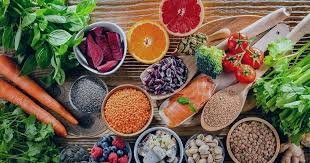Nutrition
Power in Every Bite: How food fortification is strengthening Ghana’s health

Did you know that a simple bowl of gari or salt on your table might already be helping fight malnutrition?
Across Ghana, everyday foods are being fortified with essential nutrients quietly and powerfully supporting the health of millions. This behind-the-scenes strategy, known as food fortification, is one of the most effective tools in the country’s fight against malnutrition.
While some children suffer from undernutrition, evident in stunting, wasting, and anaemia, others, especially adults, are grappling with obesity and diet-related illnesses. These issues not only affect public health but also hinder productivity and economic growth. In response, the government is strengthening its approach through food-based solutions that reach people where it matters most: their plates.
Understanding food fortification
Food fortification is the process of adding vital vitamins and minerals to commonly consumed foods to address nutrient deficiencies. In Ghana, staples like flour, salt, oil, and cereals are increasingly being fortified with iron, iodine, vitamin A, and folic acid. These enhancements target key health risks such as anaemia in women, birth defects in babies, and impaired growth in children.
The beauty of this intervention is its simplicity. People do not need to change their eating habits to benefit. By consuming fortified foods that are already part of the Ghanaian diet, families across the country can access better nutrition without added cost or effort.
Government’s role and broader goals
Government policies and partnerships have played a central role in advancing this effort. Through the enforcement of fortification standards and collaborations with local food producers, regulatory bodies like the Ghana Standards Authority and the Food and Drugs Authority are ensuring that fortified products meet safety and quality requirements. At the same time, health and agriculture ministries are working together to expand access to these foods and educate the public about their benefits.
Food fortification is also aligned with Ghana’s broader nutrition goals, including reducing child stunting and addressing anaemia among adolescent girls and pregnant women. It complements other strategies such as promoting exclusive breastfeeding, home gardening, and traditional food preservation methods.
With continued government leadership, regulatory support, and community awareness, fortified foods can become a silent but steady force in building a healthier, stronger Ghana, one meal at a time.
Feature Article by Women, Media and Change on its Nourish Ghana: Advocating for Increased Leadership to Combat Malnutrition Project.
Nutrition
Benefits of sheabutter

Shea butter is a fatty substance derived from the nuts of the African shea tree. Sheabutter has gained popularity in the Western world as a natural alternative to traditional beauty products and as a food ingredient.
Unrefined, raw shea butter is the best option for food preparation as it has not been treated with any chemicals and retains its natural properties.
-Shea butter is also a good source of vitamins and minerals. It is particularly rich in vitamin A and vitamin E, which are both known to be beneficial for the skin. Vitamin A is essential for maintaining healthy skin and eyes, while vitamin E is an antioxidant that can help to protect the skin from damage caused by UV rays and environmental toxins. Shea butter also contains small amounts of other vitamins and minerals such as vitamin K, vitamin F, and zinc. Shea butter is a good source of monounsaturated and polyunsaturated fats.
-Traditionally, Shea butter is used in cooking. It is used as a cooking oil, as well as an ingredient in soups, stews, and porridges. Another way Shea butter is consumed is as a spread on bread and as a dip for vegetables. It is also an ingredient used to make a type of fermented porridge called koko, which is made with millet, sorghum, or other grains and flavored with spices, peanuts, and Shea butter. Additionally, Shea butter is used in some traditional confections and candy sweets.
– Shea butter has been traditionally used to treat a variety of skin conditions such as eczema and psoriasis. Its anti-inflammatory properties may also be beneficial for those with joint and muscle pain.
-Eating shea butter may also benefit weight management as it is relatively low in calories and high in healthy fats. It can help to keep you feeling full and satisfied, which can help to prevent overeating and weight gain.
-As previously mentioned, Shea butter is also rich in vitamins and nutrients. It is a great source of Vitamin E that helps maintain healthy skin and eyes, and strengthen the body’s immune system against illness and infection.
Join our WhatsApp Channel now!
https://whatsapp.com/channel/0029VbBElzjInlqHhl1aTU27
Nutrition
Nutrition as smart economics: Why Ghana must invest in it
When national development is discussed, the spotlight often falls on roads, factories, employment, and technology. Yet, one of the most powerful engines of economic growth remains overlooked: nutrition. A well-nourished population is not just healthier, it is smarter, more productive, and better positioned to drive Ghana’s transformation.
The hidden cost of malnutrition
Malnutrition is not only a public health crisis; it is a silent drain on the economy. According to the Ghana Demographic and Health Survey (GDHS 2022), countries lose up to 3percent of GDP annually due to poor nutrition. For Ghana, this means billions of cedis lost every year through lower productivity, weaker educational outcomes, and soaring healthcare costs. Malnutrition robs the nation of its human capital; the very foundation of sustainable growth.
Nutrition: An investment, not an expense
The evidence is clear: nutrition delivers some of the highest returns on investment of any development intervention. Every cedi spent on nutrition generates multiple benefits:
Higher productivity: Healthy, well-fed workers contribute more to the economy.
Better education outcomes: Children who eat balanced diets learn faster and perform better in school.
Reduced healthcare costs: Preventing malnutrition lowers the burden of disease and reduces long-term treatment expenses.
In short, nutrition is not charity, it is smart economics. Ghana cannot afford to postpone action.
Why Ghana must act now
Ghana has already made bold commitments at the 2025 Nutrition for Growth (N4G) Summit, pledging to halve child stunting and reduce anemia in women. But without adequate financing and political will, these promises risk becoming empty words.
Nutrition interventions such as exclusive breastfeeding promotion, school feeding programmes, and micronutrient supplementation require sustained investment. Without dedicated budget lines and accountability measures, the cycle of malnutrition will continue to undermine development.
A call for leadership and accountability
Nutrition must be placed at the heart of Ghana’s development strategy. Policymakers, parliamentarians, and development partners need to treat nutrition with the same urgency as infrastructure or energy. Civil society organizations, the media, and citizens must also play their part by demanding accountability and ensuring that nutrition remains high on the national agenda.
The truth is simple: a nation cannot grow on an empty stomach. By investing in nutrition today, Ghana secures a healthier, wealthier, and more resilient future. A nourished Ghana is not just a healthier nation; it is a stronger, more prosperous one, ready to achieve its vision of inclusive growth.






